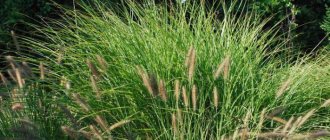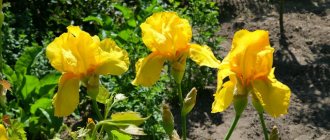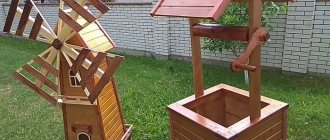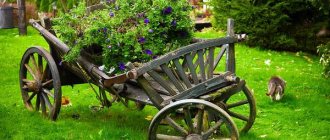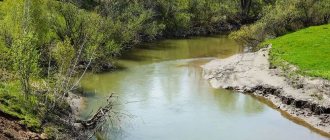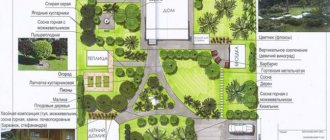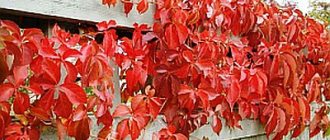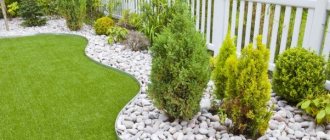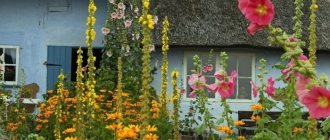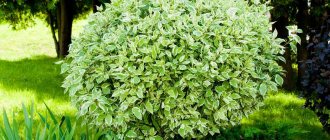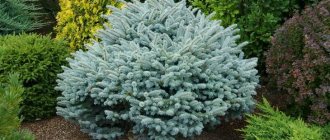Description
Sedge is a genus of herbaceous annual plants and perennials of the Sedge family. Its unpretentious and hardy representatives (more than 2000 varieties) grow throughout the globe, in temperate climates.
IN THE PHOTO: Sedge is able to take root even in conditions that are difficult for other plants.
Due to the fact that Sedge prefers moist soil, it is most often found on the banks of reservoirs and in wetlands. This fundamentally distinguishes it from other grass-like plants that grow mainly on dry soil.
There are two morphological groups of sedges:
- Sprawling . These include black sedge, sharp sedge, water sedge, nosed sedge, pointed sedge, shore sedge and bladder sedge. The rhizomes of species of this group are long, with rosettes extending from them, taking root within the growing area. As they grow, such plants create green clumps, loose or dense.
- Hummock-forming. These are drooping sedges, millet sedges, sedge-like, tall, fox-like, turfy. Their rhizomes are short and dense. They form clear and dense hummocks.
The height of sedge stems can vary depending on the type and variety. For example, the stems of some forms of high Sedge can reach 100 cm in height, in Capricorn Sedge they do not exceed 70 cm, and in the low-growing Bohemian Sedge - 30 cm.
The length of Sedge leaves reaches 30 cm. Their color varies from green (with a wide range of shades) to bluish-blue, with a border of different tones. The width of Sedge leaf blades is from 2 to 15 mm. The shape and arrangement of leaves on the stem are varied: in some species they are erect, in others they are curved into an arc.
The spikelets of inflorescences can be low-colored and low, like those of the turfy sedge, or, conversely, high, lush and large (this is how black and vesicular sedges differ).
IN THE PHOTO: Spikelets of palm sedge (Carex muskingumensis).
The color of Sedge inflorescences ranges from light tones of green to black-olive, brown and black. Narrow-cylindrical, cone-shaped or drooping spikelets give sedge clumps a special decorative effect. The fruits of plants of the genus - diaspores - are slightly biconvex or triangular in shape.
Popular varieties
Morrow sedge is usually grown on window sills, balconies and terraces, especially the varieties 'Ice Dance', 'Variegata', 'Fisher's Form', 'Goldband'. and brownish sedge, which is also graceful. Very interesting forms of the latter type are 'Jenneke', 'Jubilo', 'Lady Sunshine', 'Sophia'.
IN THE PHOTO: Sedge Morrow 'Ice Dance' variety, popular in Russia.
Winged sedge looks spectacular in the garden: the 'Knighshaye's Form' variety with bright yellow leaves, the golden-green bushes of 'Bowle's Golden', the sophisticated 'Aurea' with a yellow border. For single plantings, the “morning star” with large inflorescences measuring 2.5 cm is well suited. - Gray's sedge 'Morning Star'. The creamy white border on the leaves of the rusty-spotted sedge 'Island Brocade' gives this variety an elegant appearance.
IN THE PHOTO: Gray sedge with unusual inflorescences 'Morning Star'.
Decorative sedge - botanical information
Ornamental sedge for the garden is a perennial herbaceous plant from the sedge family, growing in all corners of the world. According to various sources, there are from 1500 to 2000 species of sedge.
Main features of the plant:
- The root system is fibrous, can be elongated or shortened, but always with adventitious roots.
- The leaf blades are narrow and sharp, arranged in three rows.
- During the flowering period, the plant is covered with flowers, which are divided into dioecious and monoecious, collected in spikelets. They have a drooping shape and hang from the stems.
When planting and caring for decorative sedge, you need to take into account that all plant varieties differ in appearance and growing requirements. They may appear as lush grass, small shrubs, or a thick “carpet” covering the ground.
Growing
Cultivated sedge can grow in greenhouses, gardens, on the banks of domestic ponds, in rock gardens and on lawns, in group plantings and living borders. Outdoors, it is better to plant the plant in a well-lit place, but under no circumstances in direct sunlight.
For black sedge, coastal and bubbly sedge, light shading is desirable. But strong shading is harmful for any variety of sedge, since it is worth remembering that the plant is a cereal that prefers well-lit areas.
The ideal soil for garden sedge is neutral (pH 6.0–7.0) or slightly acidic (pH 5.0–6.0), with a high level of humidity. Boggy soil is only suitable for certain types of sedge (leaved or coastal). Graceful and drooping sedges do not tolerate stagnant swamps.
IN THE PHOTO: Group planting of sedge bushes in the garden.
This plant needs to be fed once every two weeks (except for the winter “rest” period). Our article “Types of fertilizers and their features” will help you choose the right fertilizer for sedge in open ground or in a container.
Nuances of caring for decorative sedge
When planting and caring for decorative sedge, you must follow standard agrotechnical rules, which include following the watering and fertilizing regime, as well as regular pruning of the plant.
Basic rules for caring for decorative sedge:
- Watering should be frequent and plentiful. Care must be taken to ensure that the top layer of soil does not dry out or become crusty. In hot summers, it is advisable to water sedge at least 2-3 times a week, using 8 liters of water for each plant.
- Feeding – decorative sedge needs to be fed every 15-20 days. It is best to apply fertilizers at the same time as watering. For sedge, you can use both organic and complex mineral fertilizers.
- Pruning - carried out every spring. During pruning, you need to remove all dried, broken and diseased shoots and leaves.
Decorative sedge tolerates winter frosts well; most varieties do not require additional shelter. But for reliability, it is better to insulate the flowerbed with a layer of mulch - straw, coniferous spruce branches.
Diseases and pests
Frequent diseases of plants of the genus Sedge are gray rot and powdery mildew. The drugs Kopfugo Super, Ferazim and Derozal Euro cope with the prevention and treatment of gray rot. The spread of powdery mildew will be prevented and stopped by effective fungicides Topaz, Bayleton and Sulfarid.
Aphids, spider mites, scale insects, and mealybugs can seriously damage Sedge. Effective modern drugs to combat these mites and insects are the insectoacaricides Actellik, Actofit, Vermitek, Karbofos.
How to permanently get rid of sedge on your property
Sedge is a grass that has gained the sad reputation of one of the most invincible weeds. Ivy, gooseberry, pigweed and other nettles on the site in comparison with it are the little things in life. There are many ways to combat it, but it should immediately be recognized that it is almost impossible to get rid of sedge from a plot forever without damaging other crops and the land plot itself. The struggle will be long, difficult and with varying success. And yet, if you do not win completely, then you can put the enemy to flight. We share the observations of experienced gardeners.
Reproduction
Sedge is mainly propagated by dividing the bush. Long-rhizome species, after the formation of several shoots, are planted at almost any time. It is better to propagate and replant tussock-forming plants in the spring. How to properly replant sedge and other ornamental grasses is described in our article: “Secrets of replanting ornamental grasses in the garden.”
You can grow plants of this genus from seeds, sowing them mainly after spring warming (with the exception of rusty-spotted sedge, which is usually sown before winter). Seed propagation of most sedge species is less popular due to the risk of loss of decorativeness.
Sedge in landscape design
In landscape design, decorative sedge is used for landscaping garden plots, decorating ponds and creating cozy corners of natural nature. Most often, this plant is used for the original design of ponds and other bodies of water.
Sedge loves high humidity, so it quickly takes root on coastal soil. Lush and slightly drooping bushes of the plant harmoniously emphasize the natural attractiveness of the pond.
Ways to use decorative sedge in landscape design:
- Decorating alpine hills - the most impressive sedge looks are low-growing groundcover varieties in combination with taller ones that cover the ground between the stones.
- Design of a rockery - sedge can be placed on the sides of the composition without covering the smaller central crops.
- Landscaping shady areas of the garden - low-growing varieties of decorative sedge planted under trees create lush and thick “carpets”.
Decorative sedge is a spectacular and unpretentious plant used for landscaping garden plots and decorating ponds. Thanks to the minimal requirements for care, even a novice gardener will be able to grow a lush and beautiful plant, creating a corner of natural nature in the garden.
Secrets of success
For Sedge, it is optimal to keep it moderately cold (+15–18°C); during the rest period, you need to provide it with a temperature of +5–7°C. Like other cold-flowering ornamental grasses, sedge “awakens” at 0°C and reaches its highest growth point at a temperature of +15–24°C (if the humidity is sufficient). This must be taken into account when storing rooted cuttings.
Sedge needs a lot of fresh air. In the warm season, it is good to “ventilate” a houseplant on a balcony or terrace. But under no circumstances should you leave Sedge in a draft!
IN THE PHOTO: Air bath for young plants of the sedge variety 'Phoenix Green'.
Regular removal of dry leaves and inflorescences will preserve not only the attractive appearance of the clumps, but also the health of your home sedge.
Content:
- About Japanese sedge
- Features of Japanese sedge: review
- Growing Japanese sedge
- Planting Japanese sedge
- Watering Japanese sedge
- Reproduction of Japanese sedge
- Finally
If you're looking for a showy ornamental plant to complement your impressive herb collection, Carex morrowii, also known as Japanese sedge, will be your missing piece of the puzzle! This buddy here is not only truly adorable, but he is also very easy to deal with when it comes to his environmental and growing preferences.
What kind of Japanese sedge is this? Continue reading our guide to learn more about this magnificent plant and get to know it better!
Carex morrowii, commonly known as Japanese sedge, Morrow's sedge, kansuge, or variegated sedge, is a species of flowering grass in the family Cyperaceae. This excellent plant is native to the lower alpine regions of central to southern Japan. It grows primarily in wetland habitats such as swamps, bogs, ponds, limestone marshes, or stream banks.
Over time, Japanese sedge won the hearts of many gardeners. Apart from their obvious irresistible appearance, the casual nature of these plants has played a large role in their popularity around the world. They can grow in almost any soil and tolerate low light levels and relatively cold temperatures. In addition, once established, these grasses become drought-resistant, which is very convenient.
Ways to fight
There are several options to get rid of it forever, among them there are “lazy” ones and those that require some effort and trouble.
Traditional
The fact that the garden needs to be dug has not been in doubt for centuries, however, today not everyone agrees with this. And yet, it is digging that has been and remains one of the effective methods of combating rhizomatous perennial weeds, among which sedge is not the least of them. But plowing the land must be competent. If you dig up the area with a pitchfork rather than a sharp shovel, the sedge rhizome will receive minimal damage and will not be cut into small pieces, each of which will very soon give rise to a new weed. After such digging, you will have to pick out the roots by hand, and this is much easier to do in areas with loose, crumbly soil. If the garden is located on clay soils, the task will not be easy.
An acceptable option for mechanical tillage would be a cultivator or walk-behind tractor with a special attachment, if available. Selecting roots from the ground after this will be more difficult than after manual processing, but the result, according to reviews from gardeners, is high-quality and long-lasting. However, this method is suitable not so much for sedge as for other weeds that have a deep, powerful root system.
Chemical
Biological
For successful growth and development, plants need light, and sedge is no exception. If darkness sets in, the movement of juices in the tissues of the plant slows down and then stops altogether, and therefore the life activity itself. If there is no lighting for a long time, then first the leaves and shoots die, and then the entire root system, deprived of nutrition from above. You can deprive weeds of light using a special light-proof covering material. This can be a thick black film, roofing felt, slate, mulching agrofibre and other materials that can deprive the plant of the necessary living conditions, even ordinary wide boards. However, the method has a big and significant drawback - it is a very long process, after which it will take more than one season for a lasting result.
If soil collects on the surface of a light-proof shelter, then gradually its layer will become sufficient for the germination of the seeds that fall with it. This is especially true for non-woven covering materials.
Competent choice of covering material
The choice of material for the purpose of covering the soil will have to be taken with great care, since this issue has its own pitfalls. First of all, this concerns the black film, under which the earth warms up quite strongly, and sometimes overheats. Roofing material heated under the sun is dangerous due to the release of resins from its composition, the harmlessness of which to the site, and therefore to humans, remains a big question. Slugs quickly and easily grow under the boards, which then eat the crop with appetite. And so on.
To eliminate these nuances, you can use organic mulch, which is useful from all sides, the variety of which is very large (sawdust, small tree bark, last year’s dry leaves, mowed grass, etc.). However, to obtain the desired effect, the layer of this mulch must be thick, 5 or even 10 cm. If you put cardboard under the mulch layer, the task will be much easier. You can intelligently combine other covering materials.
It should be borne in mind that sharp and tough sedge can easily overcome loose mulch or non-woven covering material.
Substitute
Despite its tenacity, sedge grows more freely where the land is empty or relatively free. And from there it willingly takes root in all directions. Consequently, one of the ways to combat it should be the absence of unoccupied land for planting. The problem can be partially solved by using mulch or other covering material, as discussed above. But there are also more productive methods, for example, planting green manure or re-seeding fast-growing crops, for example, radishes or onions.
Another option for territorial replacement is the densification of plantings. This is a more difficult task, since it requires strict adherence to the rule of the golden mean so that thickened planting does not destroy the crop. But the method works, and you can find a lot of illustrative material on this topic on the Internet.
Alcoholic
The essence of this method, invented and first tested in America in the 30s of the last century, is extremely simple. It is necessary to prepare a 6% solution of ethyl alcohol and treat the area with it about a month before the start of sowing. You shouldn’t be afraid of the amount of alcohol spent on this; it’s only 150 ml of any vodka per 1 bucket of water. After this, the sedge, and along with it other weeds, will sprout quickly and amicably, and then pitchforks and hands come into play. Will it be possible to get rid of such a weed as sedge forever in this way? Hardly. This is just a light and deeper weeding. But the result unexpectedly exceeds expectations - it lasts for a long time (according to some gardeners, not only for the current season). This method has at least one drawback - the site must be free; for long-term plantings this option is not very convenient and can even be harmful.
Fiery
And this exotic method is already a domestic invention. And it can only be used for slow-germinating crops (carrots, parsley, etc.). In the beds with them, sedge manages to emerge earlier than the expected shoots, and along with it many other weeds. Due to their small size at this stage, it is not so easy to weed them out by hand, and it is dangerous to damage the seeds that have hatched in the ground. As a solution, gardeners pick up a blowtorch and quickly, without stopping anywhere in one place, walk through the beds with it. The method is not radical, but it will help solve the problem of the dominance of sedge and other weeds for a while until the useful shoots get stronger.
Exhaustive
Not the best, but a workable option that can be used in places where useful crops do not grow, i.e. in vacant lots. It consists of frequently mowing “to zero” or as short as possible of everything that grows on the site. In sedge, like other plants, not only the roots feed the above-ground part, but also vice versa. Essentially, this is a type of fight using a blowtorch. The destroyed interdependence of the “tops” and “roots” will greatly weaken the weed, and its reserves of vitality will soon dry up.
Sugar
It is recommended to repeat the “sugar coating” procedure several times (at least two). After the first time, the effect may not be as strong as we would like, but in one season, sedge can be removed from such areas almost forever.
Prophylactic
Very often we plant weeds on our site with our own hands. First of all, sedge seeds easily fall into the beds along with fresh manure, like the seeds of many other weeds. Rotted organic matter presents much fewer unpleasant surprises. The second source of danger is compost, in which mature herbs with ready-made seeds were placed for storage and rotting. They can be stored there for a year or two, and then sprout in a favorable environment. To prevent this scourge, follow all the rules for ripening compost - in this case, the temperature inside the heap is high enough for the seeds of sedge and other weeds to lose their germination. However, even in this case, they will die only in the center of the compost pit.
Dry
Sedge is a very moisture-loving plant. Often it is swampiness and excess soil moisture that provokes its rapid growth. It is enough to take care of high-quality drainage of the area, and part of the problem will disappear on its own. However, you should not fully count on this. That's why it is a weed, to survive in conditions that are actually unsuitable for the life of cultivated plants.
Psychological
You can take him seriously, or you can not. Everyone knows the popular expression that, without being able to change something, you can always change your attitude towards the situation. This is not a call to start a vegetable garden and give free rein to the sedge to spoil its agricultural suitability. However, by calmly accepting the fact that our personal plot is not ideal and perfect, you can save a lot of effort, nerves and money.
Source
Spreading
Northern, Atlantic and Central Europe; Baltics; European part of Russia: all regions except the west of the Volga region, the Black Earth region, the lower reaches of the Volga; Belarus; Ukraine: all regions except Crimea; Caucasus: Greater Caucasus, Georgia (Somkhetia, Javakheti), environs of Bakuriani, Borjomi, Armenia (Sevan-Shorzha basins), Azerbaijan (Mount Kyrs); Western Siberia: lower reaches of the Ob; Eastern Siberia: lower reaches of the Taz, Yenisei and Kolyma, Yenisei basin, Lena-Kolyma region (except in the north), Angara-Sayan region, Dauria (west); Far East: Southern Anyui Range, Bolshoi Anyui River basin, Udsky, Zee-Bereinsky districts, Ussuri Territory, Sakhalin, Kuril Islands (south); Central Asia: north of the Aral-Caspian region, Kazakh small hills - Karkaraly Mountains; Western Asia: Northeast Türkiye; Central Asia: Mongolia; East Asia: Northeast China and Hokkaido Island.
Grows in sedge bogs, swampy meadows, in swampy bushes and woodlands, in black alder swamps, in swampy larch forests; forms hummocks, sometimes occupying very large areas.
